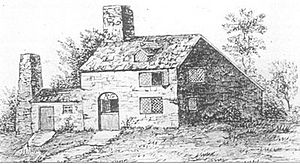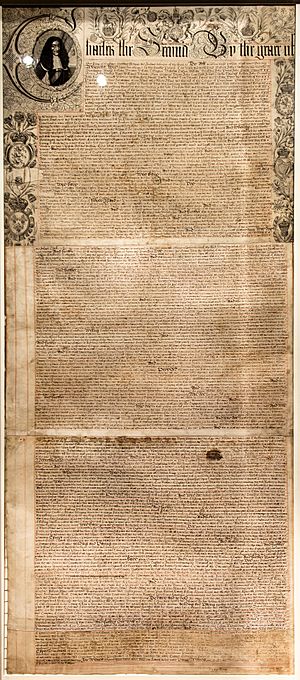John Smith (President of Rhode Island) facts for kids
Quick facts for kids
John Smith
|
|
|---|---|
| 3rd President of the Colony of Rhode Island and Providence Plantations | |
| In office 1649–1650 |
|
| Preceded by | Jeremy Clarke |
| Succeeded by | Nicholas Easton |
| 6th President of Providence and Warwick | |
| In office 1652–1653 |
|
| Preceded by | Samuel Gorton |
| Succeeded by | Gregory Dexter |
| Personal details | |
| Died | July 1663 Warwick, Rhode Island |
| Spouse | Ann |
| Occupation | Stonemason, merchant, assistant, president, commissioner |
John Smith (who died in 1663) was an important early settler in the American colonies. He became the President of the Colony of Rhode Island and Providence Plantations.
He first lived in Boston. Later, he moved to Warwick in the Rhode Island colony. There, he worked as a merchant and a stonemason. He also served as an assistant in the government.
In 1649, John Smith was chosen to be the President of the colony. At that time, the colony had four main towns. In 1652, he was elected President again. However, two towns, Newport and Portsmouth, had separated from the colony. So, he only led the towns of Providence and Warwick during this second term.
During his time as President in 1652, a very important law was passed. This law ended the slavery of African Americans. It was the first law of its kind in North America.
Contents
John Smith's Early Life and Work
John Smith first appears in official records in June 1648. He was listed as living in Warwick, Rhode Island. Before moving to Warwick, he lived in Boston. We know this from a letter written by Roger Williams in 1649.
Smith was a shopkeeper, a merchant, and a stonemason. In 1648, he also served as an assistant from Warwick. That same year, he led a special court for Warwick. This court handled cases when the main court was not meeting.
In May 1649, he was chosen to be the President of the four-town colony. He served in this role for one year.
Three years later, in 1652, John Smith was again chosen as President. This happened after William Coddington separated the towns of Newport and Portsmouth from Providence and Warwick. So, Smith only led Providence and Warwick.
A Landmark Law Against Slavery
During his second term as President, a very important law was passed in 1652. This law was against the enslavement of Black people. It was the first law in North America to deal with general human servitude.
The law stated that no Black person or white person forced into service could serve longer than ten years. If they were under 14 years old when they started, they could serve until they turned 24. At the end of their service, they were to be set free, just like English servants. Later, in 1676, the law was updated to include that no Native American could be a slave either.
Another law during Smith's time as President dealt with speaking badly about leaders. It also covered saying harmful or untrue things about others. This kind of talk was becoming a problem for the colonial leaders.
John Smith actually turned down the President's job twice when he was elected. Because of this, the General Assembly made a rule. They ordered that if an elected President refused to serve, they would have to pay a fine of ten pounds.
John Smith's Later Life
After serving as President, John Smith was listed as a freeman of Warwick in 1655. A freeman was someone who had full rights as a citizen. In the same year, he was asked to figure out how much money was owed to the Native Americans. He also had to make sure everyone paid their share. If someone refused to pay, they would get a warning from the town's Deputy.
In late 1657, John Smith took another John Smith, who was also a mason in Warwick, to court over a debt. From 1658 until his death in 1663, Smith worked as a commissioner for Warwick. A commissioner helped manage the town's affairs.
He was also named as one of the ten Assistants in the Royal Charter of 1663. This important document became the foundation for Rhode Island's government for nearly 200 years.
John Smith's belongings were listed on August 11, 1663. This suggests he died a few weeks before that date. His estate was quite valuable, worth more than 600 pounds.
Since he was a stonemason, Smith built a stone house in Warwick. It was known as "The Old Stone Castle." When Native Americans burned Warwick in 1663 during King Philip's War, this stone house was the only one that survived. The house later belonged to the Greene family. It was eventually torn down in 1779.
Family Life
John Smith married a woman named Ann. Her maiden name is not known. Ann had two children from a previous marriage: Ann and Elizur. John Smith did not have any known children of his own.
See also
 In Spanish: John Smith (gobernador) para niños
In Spanish: John Smith (gobernador) para niños



